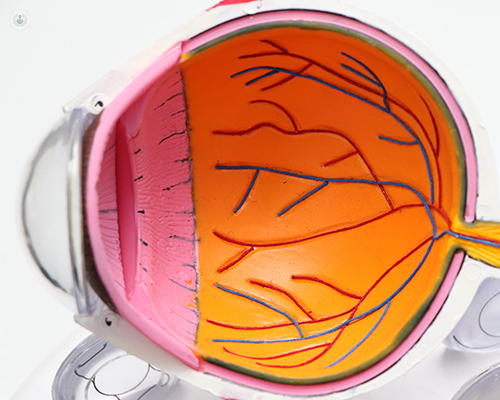The benefits of refractive surgery
Written in association with:Refractive surgery is a term used to encapsulate a group of modern, revolutionary procedures within ophthalmology, giving surgeons the ability to make life-altering impacts on their patients' lives. But what is it, and how can people benefit from the procedures? To tell us more, leading expert consultant Mr Kieran Darcy has answered questions and explained what we should know.

What is refractive surgery?
Refractive surgery helps people gain freedom from their glasses and contact lenses for all distances, including reading glasses. Although, it is not routinely available on the NHS. At Vision Care Clinic, the full range of options are offered, with procedures including laser eye surgery and all forms of lens-based surgery. Comprehensive offerings are crucial as we are all individuals and the best method for one person may be different than from another. Vision Care Clinic is proud to offer a premium, bespoke, individually tailored service.
What recent measures have been taken to help improve the results of procedures?
It is an exciting time to be a refractive surgeon. Understanding of the eye and the technology used has advanced beyond recognition. Individualised treatments explicitly designed for each patient’s eye can now be offered. This also means we can now treat people who would have previously been unsuitable. Refractive surgery can be genuinely life-changing. Helping make such an incredible change to patients' vision and lives is a true pleasure.
What is the difference between laser and lens-based solutions?
Our eyes are delicate organs that convert light into electrical impulses for the brain to interpret. Within the brain, our visual cortex turns this into an image, permitting you to see clearly. Light falls on the eye from all directions. To see clearly, a sharp focus of light is needed to hit the retina, which is the light processing part of the eye. There are two structures that help achieve this in the eye by focusing the light, the cornea and native crystalline lens.
Those who need glasses or contact lenses, there is a mismatch between the power of these two focusing elements. People who are short-sighted have a combined strength which is too high, meaning the rays of light focus in front of the retina. For people who are long-sighted, the opposite is true. Glasses and contact lenses correct the power imbalance, which allows the light to focus on the retina and create a sharp, clear image. The surgery performed achieves the same, with the aim of reducing or removing the need for glasses or contact lenses afterwards.
There are various surgical ways to attain this, and often there can be more than one which is suitable for each patient. With laser eye surgery the cornea is reshaped to either reduce or increase its power to bend light.
Modern lasers can achieve accuracies of 0.5 microns, the size of which is a tenth of the diameter of a red blood cell carrying oxygen around the body. This level of accuracy means that the overall shape can be simultaneously improved alongside changing the power if required, which sharpens the focus and improves the vision.
Intraocular lens surgery may be a better option for some patients to correct the power imbalance. For younger patients this is typically achieved by inserting an additional lens into the eye called an implantable contact lens (ICL). For patients around the age of 50 or over it is more typical to replace the crystalline lens with a new bespoke lens carefully measured to correct the focusing imbalance.
Laser eye surgery and lens-based surgery can be used to help people who also lose the ability to see things close up, something we call presbyopia.
What is cataract surgery and is this different?
When the natural crystalline lens becomes cloudy, this is called a cataract. As with glasses lenses, it needs to be transparent to see clearly. The amount of light entering the eye is scattered and reduced with any misting or loss of clarity. Over several decades, this clouding happens naturally; however, if can occur more rapidly with some diseases and trauma. Refractive lens exchange (lens replacement surgery) surgery and cataract surgery are identical. Refractive lens exchange is the term used to describe the replacement of the natural crystalline lens, correcting the power imbalance of the eye before a cataract has developed. During this procedure, the native (cloudy or clear) lens is removed and replaced with typically an acrylic lens designed to balance the power of the eye.
What is premium lens surgery?
Many different kinds of artificial lens can be inserted during both cataract or refractive lens exchange surgery. Standard lenses offer only a single point of focus: either distance (i.e. driving), intermediate (i.e. computer or mobile phone), or near (i.e. reading). If patients have other eye conditions, these may be the only options. Premium lenses have the potential to see clearly at more than one point of focus. The aim of premium lenses is to avoid the need for reading or computer glasses; these are not available on the NHS and may not be suitable for everybody. We take our time to understand the patient’s visual desire and always advise the best individual options. If it’s not possible to meet their wishes, we are very transparent and honest.
The degree of accuracy required for premium lenses is far higher than standard lenses. Attention to detail is imperative; even so, up to one in ten patients warrant a laser eye surgery enhancement to ensure the visual outcome is optimised. At Vision Care Clinic, this is included as standard care.
If you are considering having laser eye surgery, refractive lens exchange or cataract surgery or you would like more information, you can schedule a consultation on Mr Darcy’s profile.


